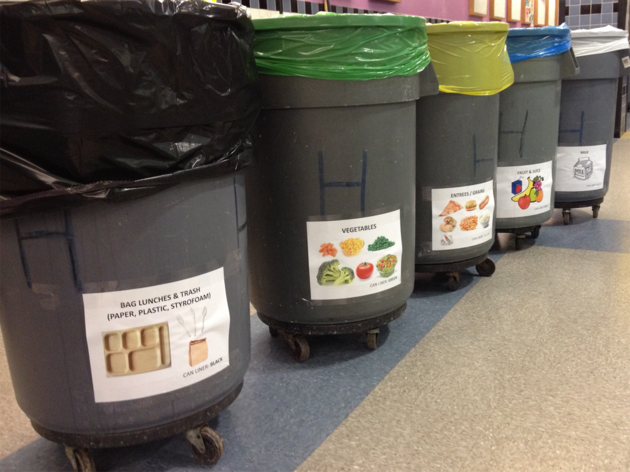Written by Juliana Cohen, Assistant Professor, Merrimack College; Adjunct Assistant Professor, Harvard TH Chan School of Public Health, and Emily Broad Leib, Director of the Harvard Food Law and Policy Clinic. Originally published by The Huffington Post on August 15, 2016.

The start of the school year is around the corner, and over 30 million children will be eating school meals every day. With this comes substantial quantities of food waste. This is nothing new- food waste has been an issue in schools for decades, and mirrors the staggering amount of food waste nationally. But it does not have to be this way. In fact, some simple but smart strategies to Reduce, Recover, and Recycle foods can make a big difference to address waste in schools. Changing practices in schools has the double benefit of reducing the amount of wasted food while also educating students about the need to reduce food waste and the ways this can be done. Catching students while they are young can help lead to the type of societal change needed to cut back on food waste.
Schools might decide on their own to implement food waste reduction plans, or they may be encouraged or forced to do so by state or local policies. However, parents (and students!) also have the power to get involved to make big changes when it comes to reducing the amount of food that lands in school trash cans.
Reducing Food Waste
First, we can focus on making changes in schools to encourage students to eat more of their healthy meals. An easy, cost-free solution is to have recess before lunch. This can significantly reduce food waste by increasing children’s appetites and removing the incentive to rush through a meal to go play outside. Many schools are receptive to this change since it is often a simple switch that can lead to students making healthier choices.
Second, giving students enough time to eat seems like an obvious way to ensure they will eat their meals, but this does not always occur in schools. In fact, there are no national standards regarding the length of school lunch periods. Research suggests that providing students with at least a 30 minute lunch period (which translates to roughly 25 minutes of seated time) leads to significant decreases in food waste. Parents can work with their school’s wellness committee to recommend an increase to the lunch period length or prevent policy changes that might make lunch periods shorter. Cities or states can even enact policies to ensure adequate student consumption time for meals.
Lastly, focusing on the palatability of the foods makes a big difference. It won’t come as a surprise to most that kids eat more when they like the taste of a food. When schools collaborate with professional chefs, students eat significantly more of their meals. Parents can work with food service directors and their school wellness committees to create a policy that encourages schools to hire a professional chef when an existing cafeteria staff member retires, or to encourage the school district to work with local chefs to help create new menus items.
Food Recovery
It’s almost inevitable that students will occasionally have foods on their trays that go uneaten. “Share tables” can help to solve this: students can swap unwanted school meal items like milk cartons, whole fruits, or bags of baby carrots. Share tables are not only safe and legal, they are also strongly encouraged by the USDA.
What about the perfectly good foods left behind on share tables, or other leftovers from the cafeteria that have not been served to children? This excess food can be donated to charitable organizations such as food banks, pantries, or other food recovery organizations. Donating this food is safe and legal, and is also supported by the USDA. Such donations are also protected from liability under federal law. Schools can work with their local food recovery organization to set up a schedule to pick up leftover food, or can work with a non-profit organization like Food Bus, which has stepped up efforts to address this missed opportunity for food recovery from schools. In order to make it even easier on schools, several states, like California and Indiana, have created documents offering best practices to help schools ensure their share tables and food donations meet the required food safety standards.
Parents can connect with food service directors and wellness committees to set up share tables in the cafeteria or help start a donation program. Resolutions can be passed at school district, city, or state level to help create awareness and encourage food donations, and cities and states can put out guidance that helps schools to comply with state food safety rules when donating their excess food.
Recycling Food
What should schools do with the half-eaten foods that can’t be donated? Many of these foods can be easily composted and used in school gardens (edible and decorative) or donated to local farms. Connecticut has created a great resource, which includes the steps and tools needed, as well as creative ideas like incorporating food recycling into the science curriculum and other teaching materials. And in the City of San Francisco, where composting of food waste is required, the city runs a citywide composting program in schools that makes composting a fun challenge for the students.
In conclusion, there are a variety of options to reduce the amount of food from schools that winds up in the landfill. Parents can work with schools to determine what they can do to support these efforts. Just remember, school employees have a lot on their plates already! Simple steps like volunteering to help establish new food policies and practices to reduce, recover or recycle food will make a big difference in ensuring a successful school year with less food waste.


Health Law & Policy, Commentary
Braidwood Management v. Becerra: Updated FAQs for Health Advocates and Providers
July 22, 2024